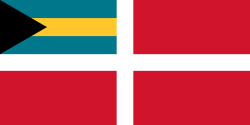 | |
| Use | National flag |
|---|---|
| Proportion | 1:2 |
| Adopted | July 10, 1973 (standardised 1 March 2006) [1] |
| Design | A horizontal triband of aquamarine (top and bottom) and gold with the black chevron aligned to the hoist-side. |
| Designed by | Hervis Bain [2] [3] |
 | |
| Use | Civil ensign |
| Proportion | 1:2 |
| Design | A white cross on a red field, the national flag in the canton |
 | |
| Use | State ensign |
| Proportion | 1:2 |
| Design | A blue cross on a white field, the national flag in the canton |
 | |
| Use | Naval ensign |
| Proportion | 1:2 |
| Design | A red cross on a white field, the national flag in the canton |

The national flag of the Commonwealth of The Bahamas consists of a black triangle situated at the hoist with three horizontal bands: aquamarine, gold and aquamarine. Adopted in 1973 to replace the British Blue Ensign defaced with the emblem of the Crown Colony of the Bahama Islands, it has been the flag of the Bahamas since the country gained independence that year. The design of the present flag incorporated the elements of various submissions made in a national contest for a new flag prior to independence.













